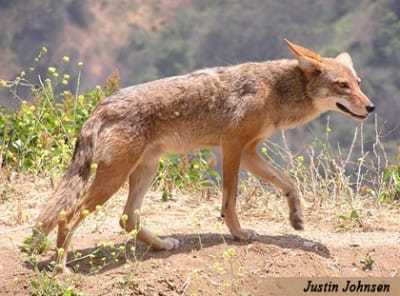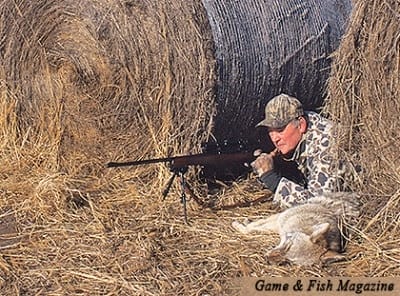By Pete Rogers, Game & Fish

When the sun creaked over the horizon, my Mojo decoy was earning its keep as it spun randomly flagging any and all predators into the long logging road I was watching. Or so I hoped. The decoy wasn’t alone: I sat hidden beneath the branches of a fallen tree whose limbs hung all the way to the ground. I was as close to being invisible as possible. My e-caller was playing a tune. I suspected hadn’t been heard in these parts before.
For the previous month, I had suffered through a period of unsuccessful calling. I was using the same old tactics that worked for years before, but for some reason I wasn’t getting anything to respond. I couldn’t get a response from howling, and nothing looked my way at the cottontail in distress, mouse squeaker, or jackrabbit. So in a fit of frustration, I had to reach deep into my bag of tricks. If I was going to find success, I had to find something that would bring in these coyotes that are wising up to the typical sounds used by most predator hunters.
As more and more hunters head to the field in pursuit of coyotes, the education level of these coyotes has grown exponentially. If we want to successfully fool the top predator in our fields and forest, we must outsmart him at his own game. And in my area, where access to farms is limited, and the forest is thick, many of the coyotes that are called in are never seen by the hunters. If they bust a hunter or two, they get more and more educated, which in turn makes them harder to kill.
When hunting educated coyotes, and by educated I mean those that have been hunted hard and often, you have to expect that these coyotes have heard virtually every variation of the cottontail and jackrabbit that can be played from every e-caller and hand call on the market. So the question remains; how do we outsmart the top predator when he knows what we are going to do before we ever get there?
Most dedicated coyote hunters I’ve had the privilege of hunting with will pull one of several tricks out of their pockets when chasing call-shy coyotes.
One such method is to look more closely at the options offered by your e-caller. Most today come with a variety of sounds or sound cards that offer the predator hunter a pure smorgasbord of sound choices. Some high-end calls come with hundreds of sounds to choose from. Choosing something new among the variety of sounds will often bring in that coyote that has “heard it all.”
By trying something they haven’t heard before you increase your odds of drawing in the smartest of these wary predators. Throw out a kid goat in distress, or a series of distressed chickens, and you will peak the interest of a call-shy coyote.
Recently I was able to put this to the test on a small parcel of land bordered by a very large cattle farm. This farm is hunted hard for coyotes both day and night. So looking at the options on my e-caller, I decided to try a “hurt Calf” sound. (A word of caution here: this will bring in every cow in ear shot, so make sure you are safe and be careful not to shoot any cows.)
When I hit the play button, the bellowing of the calf echoed through the woods. I was sitting about four hundred yards from the pasture. Looking down a long lane cut through a pine forest due to recent logging activity, I waited for a coyote to appear in front of me. Then I caught movement to my right at about ten yards, and there he was. We made eye contact and just like that he was gone. The whole event lasted not more than five minutes. But I called in a coyote using a sound I hadn’t tried before.
An e-caller offers a lot of options to the hunter when chasing educated coyotes. With the variety of calls available and the options to download more and more sounds from a lot of websites, there is really no reason that a predator hunter should lack new sounds to try.
Building confidence in them is another story — that only occurs when you use them with success.
But a key component to keep in mind is that the critter you are imitating doesn’t have to live in your area for the sound to work. Often the opposite is the case. Coyotes are predators, but first and foremost they are opportunistic. If an animal sounds hurt and it’s an easy meal, they will respond every time. Sometimes they will respond slowly, circling and testing; other times they will charge in.
I have used calls of animals that are not found anywhere near the area I’m hunting, from Magpies and Javelina, to wolf and moose calf and, as stated before, a variety of farm animals in distress.
The thing is, let them hear something they’ve never heard before. Some of my favorites are feral cats, distressed chickens, kid goats, and calves. These sounds have brought in more coyotes to my stand than cottontail and jackrabbit sounds.
Another method often overlooked by many predator hunters is changing the time of day you go after these coyotes. All dedicated predator hunters know that first light and last light are some of the best times to get coyotes to respond. But for the educated coyotes, those who are used to hearing these calls at daylight, I often wait till midday before heading out. There are not many casual predator hunters who will chase coyotes all day long. When spending a day hitting a lot of different farms and parcels, I save the parcels that are hunted the hardest for the middle of the day.

Set up where you can see as far as possible. Midday coyotes usually respond in a hurry. I seem to have the most aggressive responses at high noon. Coyotes are getting hungry, and when it’s cold outside, they respond all day long and are more aggressive than when it’s hot. Feeding builds fuel for their bodies to keep warm, so any easy meal they can get is something they will not pass up. They need to feed. Cold, rainy days have historically been the best days to get most of your action in the middle of the day.
We all have read and understand the importance of a good set up when hunting coyotes. When you hunt them in midday, they are usually laid up resting before you call. If you know where they bed or den, then you dramatically increase the odds your hunt will be successful.
Sneak in quietly, get as close to where you think the coyotes are resting as you are comfortable with, and start calling. Usually in midday, I will hit the call pretty hard at first, and taper it back pretty quickly. It’s the “get their attention, now peak their curiosity” approach.
Good scouting will play an important role in your success. Knowing your land, the topography and any natural barriers and thickets will place you in the right place to make for a successful hunt. Like always, wind will be critical, so at midday, like other times of day, get a good steady cross wind, sit in the shadows and play a sound that they haven’t heard before. Make sure you are locked and loaded because the action is coming.
Lastly, the one tool used by most top predator hunters that will bring in the most stubborn coyotes is the open reed mouth call.
Steve Thompson, owner of Dakota Predator Calls and a retired predator control officer for state game agencies said, “The open reed call has brought more coyotes to their demise than anything else I have ever tried.”
When asked why the open reed is so successful, Thompson said, “Too many hunters focus too much on trying to sound like a specific animal. I had the most success by sounding like a hurt animal — I can’t tell you if it is a rabbit, puppy or fawn.”
Thompson goes on to stress that the open reed, and to a lesser extent the bite reed, calls can make such a variety of calls that the limit is only the imagination of the caller.
“The old saying, ‘curiosity killed the cat’ is true for coyotes too.” Thompson said. And he is correct: If you can’t hit his hunger button, at least peek his curiosity, and it will bring in those coyotes that nothing else will.
By biting on the reed at different intervals, you can drastically change the sound of the call. Adjusting the airflow across the reed and cupping your hands across the tube will all change the sounds. Being a self-proclaimed addict of the art and versatility of mouth calls, I seldom go to a stand with less than seven or eight hanging around my neck. And I use a variety of different brands, and models, from howlers, to squeakers, open reed, closed reed, bite reed. And with practice, you can mimic everything from coyote pups, to raccoon kits, to cats, rabbits, crows, calves, fawns, and a variety of birds all from the same call.
In many cases, these sounds are a great tool to use when others fail. After the success of the episode mentioned earlier, I decided to try many more of the calls to see what the results would be. One thing I learned, it doesn’t matter whether the sound is from an e-caller or a hand call: using different sounds will entice coyotes to investigate.
And often using them simultaneously will be the icing on the cake. Throw out a few male challenge howls while also playing a pup in distress, and it often brings in females on a dead run.
With all of the options out there, how do we decide which is the best call for the best situation? Much of your decision should have to do with the terrain and the surrounding areas. As mentioned before, if in cattle or sheep country, use farm animal sounds — calves in distress, kid goat, chickens, and feral cats.
If you are in the thick forest of the southeast, different bird sounds and cat sounds and even baby pigs will bring in song coyotes. In the open terrain of the Midwest, the sky’s the limit: think about your specific area, and try a sound that is unique, one that you are confident the coyotes in this area haven’t heard before.
Another technique is patterning your calls to the time of year. When calling in the middle of winter, focus on easy-to-catch food — voles, deer mice, guinea pigs, and squirrels are all great sounds to use.
In the spring, all bird sounds work well, because baby birds are hatching. In fact, young of all types are being born. In the spring, I will focus all of my sounds on baby sounds. Baby raccoons, pups, feral kittens, and one of the best is a baby turkey in distress. A baby turkey doesn’t have a chance with a coyote — very young turkeys can’t out run coyotes and they can’t fly yet, so for a coyote, they are an easy meal.
When calling in May and June, nothing beats a fawn in distress. Doe deer are giving birth en masse; it is a feast for coyotes, and the best time for hunters to get some predator control on their deer leases or farms.
Coyotes will prey on young fawns and cause a significant mortality of young deer. If you really want to impact your deer herd, then drag yourself out there in late May and early June and call in some coyotes and shoot everyone you can.
As one state deer biologist said, “Every coyote you shoot is one you never have to worry about eating your fawns.”
Coyotes in farm country know when it’s calving season and know when a cow is about to birth. I have seen coyotes lying in wait for a mother cow to lie down and finish her labor. Accordingly, the sound of a calf in distress is like a dinner bell to all coyotes in the area. The same can be said of goats and chickens in distress. I actually love to watch predators when I play a chicken in distress. Fox of every color, opossums, raccoons, bobcats and coyotes will all come to the squawking and squealing of a chicken in distress call.
When hunting educated coyotes, you have to outsmart the smartest animal out there. By using different calls and sounds, you will increase your odds of fooling the wisest coyotes in the area. Mix it up, change the sounds and the time of day and you too will find a coyote in your sights.
This article was contributed by Game & Fish, a publication of Intermedia Outdoors. Visit www.gameandfishmag.com for more useful articles.
The Union Sportsmen’s Alliance website is designed to provide valuable articles about hunting, fishing and conservation for members of AFL-CIO affiliated labor unions and all sportsmen and sportswomen who appreciate hunting and fishing and want to preserve our outdoor heritage for future generations. If you would like your own story and experience from the outdoors to be considered for our website, please email us at [email protected].







